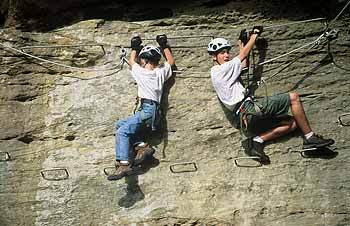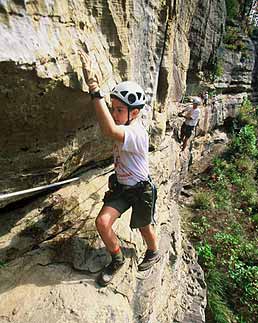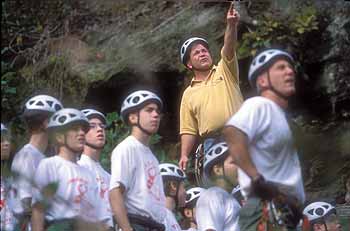Get a Grip!
By Cindy Ross
Photographs By Corey Rich
Scouts and leaders from Louisville's Troop 1 travel to eastern Kentucky's famous rock-climbing region for a new experience called a via ferrata.
 Troop 1 Scouts Trevor Kelty (left) and Josh Gray make their way along the cable climbing system known as a via ferrata ("iron path"). |
Deep in the forests of eastern Kentucky, the deck at the Torrent Falls Climbing Adventure is a flurry of rattling hardware and nervous Boy Scouts.
The novice climbers of Troop 1 have traveled from Louisville to participate in a new rock-climbing experience at the Torrent, Ky., facility. Owner Mark Meyer helps to relax them by adding a bit of humor to his instructions.
"The hardest part is getting your helmet on correctly," he says, "but don't pull the chin strap so tight it chokes you—because being able to breathe is good. And if your helmet feels too loose, turn the knob to adjust the padding—until your eyes pop out!
"And the climbing harness needs to be snug around your upper thighs...," Meyer concludes.
Along the 'iron path'
When the 18 Scouts and six adult leaders are properly suited up, they move to the base of the via ferrata rock amphitheater for a lesson in history and climbing (see sidebar).
Finished only a few years ago, the Torrent Falls Climbing Adventure is located near the Red River Gorge of eastern Kentucky, a popular area for climbing because of its heavily pocketed sandstone. The facility features the first via ferrata (Italian for "iron path") cable system in the United States; it only seems fitting that the Lincoln Heritage Council's Troop 1 should try it. (Chartered to the Crescent Hill United Methodist Church in Louisville, the troop was one of the first in the Bluegrass State.)
Meyer hired a French via ferrata building team and a geologist to install the climbing route around the 3,400-foot rock amphitheater. It features fixed footsteps and handgrips, made of highway construction reinforcement bar and cemented with Epoxy into the rock along the "self-belaying" cable system. Bolts were tested at 9,500 pounds of force and the cable at 14,400 pounds.
As they make their way along the cliffside route, climbers are never disconnected from the cable and are always clipped into at least one point of protection. When they reach one of the bolts (located three to 10 feet apart) that hold the cable in place, they use the self-locking carabiners connected to their climbing harness to clip and unclip their way around it.
 Stephen Herde relies on a footstep. |
The farther you go...
The course starts at a beginner level and progresses to color-coded levels of increasing difficulty. Climbers can enter or leave the course at any of five downward exits along the route.
Climbers can also rest by clipping their short webbing strap to the cable and sitting in their harness while enjoying the view.
The Scouts can see and hear each other as they move along the cable, which is fully monitored from below by employees certified in rescue, climbing, and CPR.
"Use a buddy system," Meyer tells the Scouts. "Wait on your partner to catch up but have only one climber on each cable section at a time."
The older boys head to the start of the advanced route while the 10- to 13-year-olds beeline for the beginner/family section. One adult is placed with every four or five boys, attempting to pair speed, ability, and strength so the climbing group will not bottleneck.
Many Troop 1 Scouts have had experience on an indoor climbing wall, but only a few have been on a wild outdoor face.
"This is going to be great!" a Scout declares as the group heads up the dirt trail to the base of the cliff.
 Assistant Scoutmaster Mitch Gray points out the route to Scoutmaster Barry Bridges and his Scout climbers. |
'You're almost done!'
From a trail along the base, those not climbing can hear the Scouts' comments and watch their progress and techniques. On the wall, climbers ask each other for help in spotting hard-to-see footholds and remind each other to pay attention while unclipping and clipping around a bolt.
On the beginner route, the Scouts soon relax and enjoy the experience. They sing songs (the theme from "Spiderman" and "I Believe I Can Fly"), listen to their voices echo, and call greetings to the older Scouts on the advanced route. But their favorite activity is sitting back in their harness and taking in the view. ("I can see everything up here!")
Meanwhile, the older boys and their leaders on the advanced course find they need to rely on encouragement and direction from each other.
There's a lot of lip wetting, sighing, and resting to gain composure and strength. Once Robbie Steinbock and Josh Gray, both 14, round the point that marks the end of the course, they offer encouragement to 16-year-old Chet Gray moving up behind them.
"You're almost done," they tell him. "Round the corner, and you're there!" Chet takes a few deep breaths, settles himself, rests a moment, and negotiates the move flawlessly.
Next comes the Rev. Jim Seelhorst, pastor of Crescent Hill United Methodist Church and a 46-year-old Scouter who is not bashful about asking the boys for help in making the final steps around the point. "What's the secret?. . .How did you do that?" he asks, before successfully joining them at the exit.
Challenges for everyone
As they leave the beginner course and enter the intermediate level, some younger climbers decide they've gone far enough. Staff and leaders coach them back to the beginner exit.
"I wasn't ready for the next level," 11-year-old Trevor Kelty admits. "I just didn't have the upper body strength to do it."
"I saw Trevor having difficulty," says his partner, 12-year-old Jeff Freibert, "and I decided I couldn't go on either. I know I'm not that advanced yet and it was O.K. to turn back."
The via ferrata experience lets climbers realize their limitations while also overcoming their fears. For example, Andrew Mertz, 13, acknowledges that the beginner course represented a personal achievement: "I was so afraid of heights before, but up there, I felt safe, and I didn't mind it at all that I didn't go beyond the beginner level."
The course offers challenges for everyone, Scoutmaster Barry Bridges says. "And we'll come back next year and try again, because if each Scout keeps trying [the next level], sooner or later he'll succeed. That's what we try to teach our Scouts, and climbing the via ferrata is a great way for them to learn that lesson."
In the January-February 2004 issue, Cindy Ross described a Connecticut troop's annual winter trek in New York State's Adirondack Mountains.
From the Alps to Eastern KentuckyDuring World War I, in order to move thousands of troops laden with heavy packs and guns over the dizzying heights of the Alps, the Italians developed a safe cable system called a via ferrata, or iron path. When the war ended, people began using the system for recreation, and today it has developed into a sport. In the European Alps, there are more than 300 systems with published guidebooks. The climbing season at the Torrent Falls Climbing Adventure in eastern Kentucky is March 1 to Dec. 1. The fee of $29 for adults, 18 and up, and $26 for youth, 10 to 17 years, includes equipment, a one-day pass, and instruction. Scout troops receive a 10 percent discount off the regular one-day fee and a second day for only $10 per person. Also available is a six- to eight-hour Climbing merit badge instruction session for $39 per Scout. And troops can camp at no charge in the shadow of the via ferrata course. Contact: Torrent Falls Climbing Adventure, 1435 North KY 11, Campton, KY 41301, (606) 668-6613, torrentfalls@mrtc.com. For more information, see www.torrentfalls.com. The Blue Grass Council's McKee Scout Reservation, between Clay City and Mount Sterling, about 25 miles from Torrent Falls, offers year-round camping for Scouts. Contact the council (www.bgbsa.org) in Lexington at (859) 231-7811. |
October 2004 Table of Contents
Copyright © 2004 by the Boy Scouts of America. All rights thereunder reserved; anything appearing in Scouting magazine or on its Web site may not be reprinted either wholly or in part without written permission. Because of freedom given authors, opinions may not reflect official concurrence.